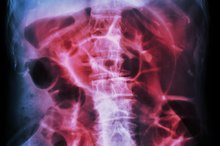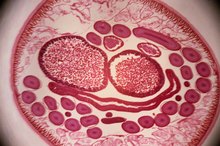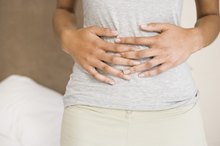Acute Hemorrhagic Pancreatitis Symptoms
Acute hemorrhagic pancreatitis is the sudden inflammation of the pancreas 1. This leads to death of pancreatic tissue and the formation of lesions, causing extensive bleeding. The pancreas is a digestive organ behind the stomach that secretes essential enzymes needed for the digestion of certain foods, including fats, carbohydrates and proteins. During an episode of acute hemorrhagic pancreatitis, several symptoms relating to digestion and abdomen may occur 1.
If you are experiencing serious medical symptoms, seek emergency treatment immediately.
Abdominal Pain
One of the hallmark symptoms of acute hemorrhagic pancreatitis is abdominal pain--particularly in the area of the pancreas, the upper middle or left side of the abdomen, explains MedlinePlus 1. The pain often increases in severity, turning into a constant pain that lasts for several days. The pain often worsens in the few minutes after eating or drinking--especially if the meal contains high amounts of fat or is accompanied by large amounts of alcohol, explains an article published in the July 2000 issue of American Family Physician. Lying down flat on the back often makes the pain worse. In severe cases, the pain can spread to the side, back or lower left shoulder.
- One of the hallmark symptoms of acute hemorrhagic pancreatitis is abdominal pain--particularly in the area of the pancreas, the upper middle or left side of the abdomen, explains MedlinePlus 1.
- In severe cases, the pain can spread to the side, back or lower left shoulder.
Flu-Like Symptoms
High Levels of Alkaline Phosphatase & Pancreatitis
Learn More
An episode of acute hemorrhagic pancreatitis often causes severe flu-like symptoms 1. Nausea and vomiting are frequent symptoms, occurring in approximately 85 percent of patients with acute hemorrhagic pancreatitis, according to the Johns Hopkins Department of Gastroenterology and Hepatology 12. A person may also experience a high fever, accompanied by sweating, a take on a generally ill-looking appearance.
Digestive Problems
In people with acute hemorrhagic pancreatitis, the pancreas does not produce enough digestive enzymes 1. This can have a variety of effects on the digestive system. The patient may develop clay-colored stools, reports MedlinePlus. Hiccups and indigestion are also frequent symptoms. A feeling of abdominal fullness and gaseous bloating may also develop. Another possible symptom is jaundice, a yellowing of the skin and eyes.
- In people with acute hemorrhagic pancreatitis, the pancreas does not produce enough digestive enzymes 1.
- A feeling of abdominal fullness and gaseous bloating may also develop.
Severe Complications
Stomach Aches & Back Pain
Learn More
More severe symptoms may also develop in a person with acute hemorrhagic pancreatitis--including confusion, difficulty breathing, respiratory failure or coma, the John Hopkins Department of Gastroenterology and Hepatology explains 12. Kidney failure can also result from acute hemorrhagic pancreatitis, which may require kidney dialysis, according to the Medical University of South Caroline Digestive Disease Center 1. The hemorrhaging pancreas can also leak harsh digestive enzymes into the bloodstream or body cavity, which can damage other internal organs such as the heart and lungs.
Related Articles
References
- MedlinePlus: Acute Pancreatitis
- Johns Hopkins Department of Gastroenterology and Hepatology: Acute Pancreatitis
- "American Family Physician"; Diagnosis and Management of Acute Pancreatitis; Abilio Munoz and David A. Katerndahl; July 2000
- Afghani E, Pandol SJ, Shimosegawa T, et al. Acute pancreatitis-progress and challenges: a report on an international symposium. Pancreas. 2015;44(8):1195-210. doi:10.1097/MPA.0000000000000500
- Yadav D, Lowenfels AB. The epidemiology of pancreatitis and pancreatic cancer. Gastroenterology. 2013;144(6):1252-61. doi:10.1053/j.gastro.2013.01.068
- Krishna SG, Kamboj AK, Hart PA, Hinton A, Conwell DL. The changing epidemiology of acute pancreatitis hospitalizations: a decade of trends and the impact of chronic pancreatitis. Pancreas. 2017;46(4):482-488. doi:10.1097/MPA.0000000000000783
- Yoshida S, Okada H, Nakano S, et al. Much caution does no harm! Organophosphate poisoning often causes pancreatitis. J Intensive Care. 2015;3(1):21. doi:10.1186/s40560-015-0088-1
- Afghani E, Pandol SJ, Shimosegawa T. Acute Pancreatitis-Progress and Challenges: A Report on an International Symposium. Pancreas. 2015;44(8):1195–1210. doi:10.1097/MPA.0000000000000500
- Huh JH, Jeon H, Park SM, et al. Diabetes mellitus is associated with mortality in acute pancreatitis. J Clin Gastroenterol. 2018;52(2):178-183. doi:10.1097/MCG.0000000000000783
- Chatila AT, Bilal M, Guturu P. Evaluation and management of acute pancreatitis. World J Clin Cases. 2019;7(9):1006-1020. doi:10.12998/wjcc.v7.i9.1006
- Shah AP, Mourad MM, Bramhall SR. Acute pancreatitis: current perspectives on diagnosis and management. J Inflamm Res. 2018;11:77–85. Published 2018 Mar 9. doi:10.2147/JIR.S135751
- National Pancreas Foundation. Acute pancreatitis causes and symptoms.
- Mandalia A, Wamsteker EJ, DiMagno MJ. Recent advances in understanding and managing acute pancreatitis. F1000Res. 2018;7:F1000 Faculty Rev-959. Published 2018 Jun 28. doi:10.12688/f1000research.14244.2
- Uc A, Andersen DK, Bellin MD. Chronic pancreatitis in the 21st century - research challenges and opportunities: summary of a National Institute of Diabetes and Digestive and Kidney Diseases workshop. Pancreas. 2016;45(10):1365–1375. doi:10.1097/MPA.0000000000000713
- National Pancreas Foundation. Chronic pancreatitis causes and symptoms.
- Lew D, Afghani E, Pandol S. Chronic pancreatitis: current status and challenges for prevention and treatment. Dig Dis Sci. 2017;62(7):1702–1712. doi:10.1007/s10620-017-4602-2
Writer Bio
Matthew Busse has pursued professional health and science writing since 2007, writing for national publications including "Science Magazine," "New Scientist" and "The Scientist." Busse holds a doctorate in molecular biology from the University of California-San Diego.








